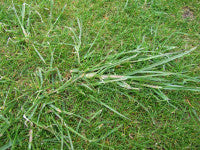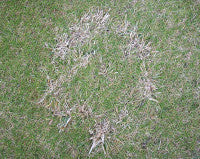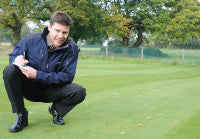iTurf approach for autumn Rescue programme
 A new programme for Rescue treatments will further help greenkeepers and bowling green managers remove rogue Ryegrass and ensure better establishment of fine turf grass seedlings, to quickly improve playing surface quality this autumn. Developed under the Everris iTurf programme, the Integrated Turf Management approach incorporates innovative soil and nutrient management, alongside the herbicide treatment and over seeding.
A new programme for Rescue treatments will further help greenkeepers and bowling green managers remove rogue Ryegrass and ensure better establishment of fine turf grass seedlings, to quickly improve playing surface quality this autumn. Developed under the Everris iTurf programme, the Integrated Turf Management approach incorporates innovative soil and nutrient management, alongside the herbicide treatment and over seeding.
Stuart Staples, International Technical Manager of Everris (formerly known as Scotts) advises the use a wetting agent prior to over seeding is important to help maintain soil moisture around the seed to ensure optimum germination. In the run up to Rescue treatment he advocates a sequence of wetting agent and a slow release fertilizer with a good N source, such as Sierraform GT Autumn 18-6-18 + 2%MgO+TE.
"Applying a slow release fertilizer at this stage helps ensure the Ryegrass is actively growing when Rescue is applied, so we get a rapid uptake of herbicide into the plant and active translocation down into the roots, to get the best possible kill," he said.
But Mr Staples warns that applying the wrong fertilizer, with too much readily available nitrogen, prior to over seeding has been shown to physically restrict germination by up to 16%, compared to Sierraform GT slow release fertilizer. Trials have shown the low salt content of Sierraform GT means it has no adverse effect on germination, so can be applied pre- or post over seeding, he advised.
Mr Staples highlights that a grass seed contains all the nutrients the seedling requires for the initial germination, but after that it's imperative to provide adequate nutrition to get the plant well established. He advocates an application of a slow release fertilizer with a higher phosphate content, such as Sierraform GT Pre-Seeder 18-22-05, at or soon after the time of seeding that will provide a sustained source of all the essential nutrients throughout the establishment phase and promote greater root development.
"Sierraform GT will go on providing a consistent daily source of nutrients for six to eight weeks after application. It avoids the quick release of nutrients seen with conventional fertilizers, which can result in a flush of top growth with limited root growth that is weak and susceptible to disease and other environmental stresses."
Work with Syngenta, at the STRI and with extensive user trials, has also shown that Primo Maxx application around five days prior to over seeding can also significantly improve seedling establishment, by suppressing competition of the existing turf sward and allowing young seedlings to develop.
 Syngenta Technical Manager, Dr Simon Watson, reported STRI trials have shown the optimum time for over seeding is around seven days after Rescue application. He adds that in user trials, however, some greenkeepers have even over sown before the herbicide treatment, which can work effectively providing they are only sowing Fescue grass species.
Syngenta Technical Manager, Dr Simon Watson, reported STRI trials have shown the optimum time for over seeding is around seven days after Rescue application. He adds that in user trials, however, some greenkeepers have even over sown before the herbicide treatment, which can work effectively providing they are only sowing Fescue grass species.
"The aim with the over seeding is to achieve rapid surface recovery as any Ryegrass dies back and ensure any new seedlings are well established before the winter. It's important to time Rescue application when there is active growth in the target weeds, and whilst there is still good time for recovery of turf surface quality before the winter, either from new seedlings or the spread and in-fill of existing turf," he advised.
"It remains important for turf managers to plan and accurately assess the sward composition prior to Rescue treatment, to decide if over seeding will be required, and to fully utilise the benefits of the iTurf programme to assure a good result."
